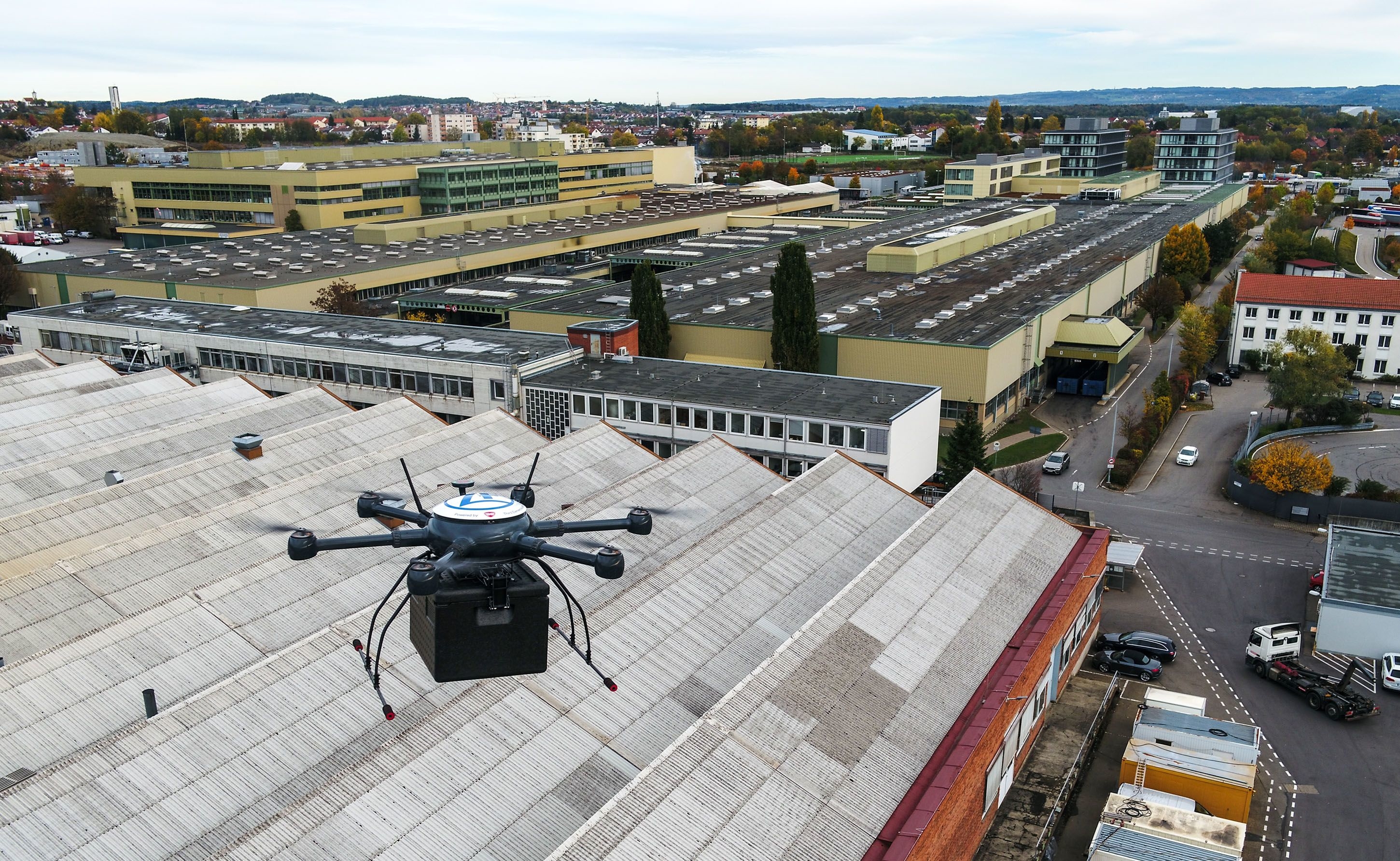Impressive advancements have been made in drone technology over the last few years and many believe that drones will play a key role in the logistics of the future, for internal business functions as well as deliveries to consumers. In fact, NASA estimates that there will be 7m drones in US skies alone by 2020.
US consultancy McKinsey, meanwhile, projects that autonomous vehicles, including drones, will deliver 80% of all items in the future. The firm predicts that, at some point, driverless vehicles, loaded with parcels by robots at a warehouse, will automatically dispatch multiple drones when nearing the point of delivery. Such vehicles would serve as a base station for the drones, providing charging and payload swapping as required.
In the nearer term, PwC estimates that more than 76,000 drones will to take to the skies in the UK over the next 12 years, with as many as 11,000 deployed in the transport and logistics sector. PwC suggests that the growing adoption of drone technology across the transport and logistics sector could drive a GDP boost of £1.2 billion ($1.6 billion) and, with an uplift in productivity, cost savings in the region of £2.8 billion over the same period.
“Current studies forecast a huge growth in industry drone application,” says Philipp Wrycza, research fellow at Fraunhofer IML, who explains that there are three main uses for drones in the automotive industry: transportation, stocktaking and inspection.
“We did a study with an OEM and the time for delivering urgent goods can be reduced from 15 minutes to under five minutes with a drone,” says Wrycza. “They operate with less infrastructure than other technologies, for example–stocktaking without forklifts and personnel.”

In 2017, the Fraunhofer institute spun off a supply chain start-up, doks.innovation, in Dortmund which now provides drone and sensor technology for the logistics sector and has contracts with a range of companies in the automotive industry.
One of Doks’ inventions is an automated stocktaking and inventory management drone, the inventAIRy, which works in concert with autonomous guided vehicles or forklifts.
The drone flies for about 25 minutes per session, collecting stock data on both aisles of a warehouse at the same time, meaning two racks per flight. The inventAIRy manoeuvres inside the building without GPS, using visual information for simultaneous localisation and mapping.
Doks says that in place of two to three employees and one forklift for each team, the drone is able to save up to 80% of process time for stocktaking, reducing up to 90% of expensescompared with manual processes.
OEMs take stock
Vehicle-makers such as BMW and Škodaare also investing in drone technology to autonomously conduct real-time stock checks.
BMW, for example, has started to use dronesat its factory in Leipzig to count external storage bins for parts – work that was previously done by personnel. It currently has one multicopter drone running outside constantly.
The drone takes 129 photos with a 4K camera from multiple different angles and an algorithm creates a 3D model from the pictures, showing how many bins are stacked and enabling them to be counted automatically. The process is much faster than before, and means that human workers are not exposed to poor weather conditions.
BMW is currently testing the technology in one bin area in Leipzig and is checking whether the application could be used at other locations.
Meanwhile, Skoda is trialling an autonomous drone to identify and count containers outside its factory in Mladá Boleslav, Czech Republic.
During the current testing phase, the drone is recording the number of empty containers outside the building three times per day and automatically transferring this data to the logistics department’s IT systems.
As GPS is not precise enough to determine the location of the containers, the drone is equipped with a lidar (light detection and ranging) sensor, which captures up to 300,000 images per second. The six-rotor drone can at fly up to 20kmph and carry a load of up to 5kg.
Skoda’s spokesperson, Kamila Biddle, says: “We appreciated the practicality of using a drone, especially in winter when the weather was not very pleasant for staff. This technology helps to increase the efficiency of our everyday production processes and make our employees’ work easier.”
Biddle adds: “The drone facilitates and speeds up the inventory process, helping our employees to improve efficiency and reduce errors. In the future, such processes will be automated.”
In the next stage of development, the drone will have a ‘charging nest’, which the OEM plans to deploy in other logistics areas, including warehouses. The nest will mean that the battery-powered device will be able to autonomously navigate to a charging station.
Part of the process
Component manufacturer ZF has started testing the use of a drone to distribute parts at its main plant in Friedrichshafen, south-west Germany. The company was the first in Germany to receive official approval for automated drone flights over factory premises.
A drone prototype is currently flying spare parts such as sensors or control cards from the central warehouse to workshops onsite.
Matthias Haberstroh, director supply chain management division, ZF says: “As soon as the test flights are complete and drones [are] properly deployed, such flights will relieve vehicle traffic at the plant and save time on the up to 1km-long delivery routes that are often on the upper floors of buildings.“In the long term, packages could even be delivered outside of factory premises, for example to facilitate package delivery in residential areas that are difficult to access.”
He believes that automotive companies can benefit from the experiences of other industries: “We can learn a lot from companies like Amazon, where, for example, drones can be integrated as a component in an overall process, especially in the digital ordering and processing process.”
 Matthias Haberstroh, director of supply chain management division, ZF
Matthias Haberstroh, director of supply chain management division, ZFHe explains that this goes beyond technical processes: “We can also learn how new business models can be developed. In addition, these industries are certainly further in terms of venture capital approach and agile approach.”
According to Simon Pleass, MD of Irish warehousing, logistics and fulfilment company, 2Flow, last mile delivery is as one area that would particularly benefit from the use of drones.
“There are several advantages of using drones to deliver parts, including faster and cheaper fulfilment, lower shipping costs, more sales and higher revenue, reduction in the environmental impact of delivery and last mile connectivity to remote locations,” he says.
“This [last mile delivery] is the most difficult and expensive leg of a package’s journey,” says Pleass, who notes that 50% of the total distribution cost can be attributed to this final mile.
Pleass suggests that drone delivery could help to optimise this by transporting packages from a local distribution centre to a specific address, thereby “slashing the travel time and increasing efficiency”.“The technology could massively disrupt last-mile delivery,” he concludes.
Turbulent technology
Drones differ from some other emerging technologies in that their use impinges on airspace safety, meaning the technology will need to comply with regulation as it evolves.
“It is not surprising that an industry which has exploded into existence and is expanding more rapidly than any before is somewhat turbulent and difficult to navigate,” says Robert Garbett, founder of drone technology consultancy, Drone Major Group, which has so far mapped more than 250 applications for drone systems.
“The biggest problem facing the industry in the UK right now is the inability for manufacturers and operators to rapidly and easily test and evaluate their technology and concepts beyond visual line of sight and in vertical take-off and landing modes due to the onerous nature of the permission system currently in place.”
Drone Major Group recently formed the Drone Delivery Group to provide industry guidance to the UK government on this matter.
Pleass of 2Flow agrees that the law currently represents the “single biggest obstacle facing delivery drones” as many countries have regulations in place restricting the flight of commercial drones in many areas.
Air drone regulationsare stipulated in the Air Navigation Order 2016 (ANO 2016), which was recently amended in light of an incident at London Gatwick Airport, in which hundreds of flights were cancelled following sightings of a drone. The exclusion zone around UK airports was subsequently extended from 1km (0.6 miles) to 5km.
Garbett suggests that the existing regulations are sufficient for current commercial operations, but further laws may be required to enable more widescale operational adoption of drones in logistics roles.
“The current rules require all flights beyond visual line of sight to be approved by the Civil Aviation Authority,” he says. “The process for achieving this is onerous and, as a result, is hampering the development of the industry. To achieve this [development], we will need to establish comprehensive foundation standards which could support the development of suitable regulations to enable further growth.
Garbett explains that both the British Standards Institute and the International Standards Organisation are working hard to establish safety and quality foundation standards which will provide this support, but this will “take some time”.
Further challenges to the industry include the problem of limited battery power, meaning that currently a single drone carrying one package to a single destination can fly just a little over two miles. In addition, unlike delivery trucks which can carry hundreds of packages at a time, cargo drones typically have a capacity of just 5kg.
Sky’s the limit?
Although some companies are seriously exploring the use of drones, others have tended to view them as more of a toy or experiment than a cost-effective tool. “Some analysts naturally confused rising recreational drone sales with an industry boom which generally only occurs as a result of a fundamental shift in commercial industries which bring long-term benefits and utility,” says Garbett. “The commercial sector, hampered by bad press and slow-to-arrive regulations, is now starting to accelerate, but what shape will that future take and will it accelerate again or stabilise?”
 Robert Garbett, founder of Drone Major Group
Robert Garbett, founder of Drone Major GroupGarbett suggests this is extremely difficult to predict and that even the most “drone-savvy” analysts can only guess. In his own view, the future of the drone industry is “undoubtedly very bright” but not necessarily “what many envisage”.
“It is my belief that in order to flourish as a global ‘life-changing’ industry, it [drone technology] must tackle those issues faced by a modern civilisation much in the same way as the automotive industry did over 100 years ago.”
This, Garbett suggests, means delivering solutions to reduce the congestion and safety issues of current automotive operations through the evolution of autonomous vehicles transporting freight by ground, sea and air.
Garbett concludes: “The industry as a whole is flourishing and things will continue to shift rapidly as pure air [transport] moves to multi-modal; RPAS (Remotely Piloted Aircraft Systems) loses to autonomous [technology]; and trends evolve from small-scale delivery to large-scale changes in our transport systems.
“The applications for drone technology, across all environments, continue to grow alongside the understanding of just how much value this technology can bring to a wide range of business sectors, so [automotive logistics] is definitely in the right industry, but get ready for a long and bumpy ride.”
Transport and supply chain management provider Ryder is using drones to map its warehouses and update data on inventory and facility conditions. Gary Allen, vice-president of supply chain excellence at the company, says: “Manually, this task could take two or more employees and at least one scissor lift to complete. By using drones, employees are better able to focus on value-added functions, assets are freed up, and the task can be completed up to 66% faster.”
At a Ryder customer warehouse in the US, drones havesuccessfully scanned pallets and locations in 20 minutes, compared with a manual scan taking around 90 minutes. A cycle countonthe entire warehouse took just three hours versus two days. The drone canalso identify available pallet locations and verify product placement.
In Mexico, Ryder is also using drones to tackle vandalism and theft. There has been a major increase in vehicles being stolen in the country, including during transport. As delegates heard at the AL Mexico conference in January (see p50 of the April-June 2019 Automotive Logistics magazine for the report), the Association of Mexican Insurance Companies (AMIS) has found that 93,000 vehicles were reported to insurers as stolen over the last 12 months, but these represent only a fraction of the true volume, given that just 30% of vehicles in Mexico are actually insured.
Alfonso Negrete,director of automotive and cross border operations for Ryder Mexico, commented to Automotive Logistics: “If you’re moving high-value automotive products [such as] tyres and radios, you need to increase your security.”
The drones have a specific routine in which they circle around the facility, providing a visual of the surrounding area, which is recorded. “Sometimes with a higher view you may see different aspects you wouldn’t see from inside your walls, and usually the threats are from outside your walls,” explains Negrete.After trialling the technology, Ryder is now looking at sending a drone to specific streets near its facilities, so that it can check there is no threat to its fleet. “If someone [stays] three hours in the same place, you need to ask yourself ‘why is he still there’?” comments Negrete.
While Ryder has not been collecting data on it, Negrete believes drone technology is making an impact at Ryder Mexico: “I say that because we haven’t seen an increase in the number of incidents”.

























![Global[1]](https://d3n5uof8vony13.cloudfront.net/Pictures/web/a/d/s/global1_726550.svgz)















